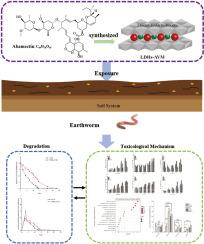A nano-pesticide with low toxicity for earthworms obtained by immobilizing avermectin onto Mg/Al layered double hydroxides
IF 7.3
2区 环境科学与生态学
Q1 ENVIRONMENTAL SCIENCES
引用次数: 0
Abstract
Nanopesticides offer significant advantages, such as enhancing pesticide bioactivity, increasing efficacy, and reducing overall usage. However, knowledge gaps regarding their environmental risks to non-target organisms hinder the industrial adoption of nanopesticides. In this study, abamectin was selected as a model pesticide, and earthworms (Eisenia foetida) were employed as representative non-target organisms to evaluate the environmental behavior and ecotoxicity mechanisms of abamectin-loaded layered double hydroxides nanopesticide (Mg/Al LDHs-AVM) in soil systems. The dissipation rate of LDHs-AVM in soil was 2.9-fold slower than that of abamectin technical (AVM TC). Compared with AVM TC, Mg/Al LDHs-AVM significantly reduced the accumulation of the active ingredient in earthworms by 35 %. Furthermore, Mg/Al LDHs-AVM enhanced the antioxidant and detoxification capacities of earthworms through Mg/Al LDH nanoparticles (Mg/Al LDHs), significantly upregulating detoxification-related genes (EfCYP2U1, EfADH1, EfGST-III, and EfGSTt1) involved in the CYP2E1 and glutathione (GSH) biosynthesis pathways by 2.8- to 22.5-fold. Compared to AVM TC, Mg/Al LDHs-AVM could significantly reduce the MDA content in earthworms by half. These findings provide the first comprehensive safety assessment of Mg/Al LDHs-AVM, offering a novel approach to mitigate the ecotoxicity of AVM TC to non-target organisms through LDH NP-mediated delivery.

将阿维菌素固定在Mg/Al层状双氢氧化物上制备了一种对蚯蚓低毒的纳米农药
纳米农药具有显著的优势,如增强农药生物活性、提高药效和减少总体使用量。然而,关于它们对非目标生物的环境风险的知识差距阻碍了纳米农药的工业应用。本研究以阿维菌素为模型农药,以蚯蚓(Eisenia foetida)为代表性非靶生物,评价了负载阿维菌素的层状双氢氧化物纳米农药(Mg/Al LDHs-AVM)在土壤系统中的环境行为和生态毒性机制。LDHs-AVM在土壤中的耗散速度比阿维菌素技术(AVM TC)慢2.9倍。与AVM TC相比,Mg/Al LDHs-AVM显著降低了蚯蚓体内活性成分的积累量,减少了35%。此外,Mg/Al LDHs- avm通过Mg/Al LDH纳米颗粒(Mg/Al LDHs)增强了蚯蚓的抗氧化和解毒能力,显著上调了参与CYP2E1和谷胱甘肽(GSH)生物合成途径的解毒相关基因(EfCYP2U1, EfADH1, EfGST-III和EfGSTt1) 2.8至22.5倍。与AVM TC相比,Mg/Al LDHs-AVM能显著降低蚯蚓体内MDA含量一半。这些发现首次对Mg/Al LDHs-AVM进行了全面的安全性评估,为通过LDH np介导的递送减轻AVM TC对非靶生物的生态毒性提供了一种新方法。
本文章由计算机程序翻译,如有差异,请以英文原文为准。
求助全文
约1分钟内获得全文
求助全文
来源期刊

Environmental Pollution
环境科学-环境科学
CiteScore
16.00
自引率
6.70%
发文量
2082
审稿时长
2.9 months
期刊介绍:
Environmental Pollution is an international peer-reviewed journal that publishes high-quality research papers and review articles covering all aspects of environmental pollution and its impacts on ecosystems and human health.
Subject areas include, but are not limited to:
• Sources and occurrences of pollutants that are clearly defined and measured in environmental compartments, food and food-related items, and human bodies;
• Interlinks between contaminant exposure and biological, ecological, and human health effects, including those of climate change;
• Contaminants of emerging concerns (including but not limited to antibiotic resistant microorganisms or genes, microplastics/nanoplastics, electronic wastes, light, and noise) and/or their biological, ecological, or human health effects;
• Laboratory and field studies on the remediation/mitigation of environmental pollution via new techniques and with clear links to biological, ecological, or human health effects;
• Modeling of pollution processes, patterns, or trends that is of clear environmental and/or human health interest;
• New techniques that measure and examine environmental occurrences, transport, behavior, and effects of pollutants within the environment or the laboratory, provided that they can be clearly used to address problems within regional or global environmental compartments.
 求助内容:
求助内容: 应助结果提醒方式:
应助结果提醒方式:


